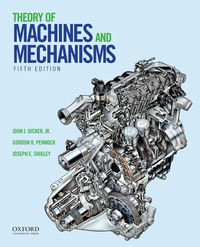The differential gear train has gear 1 fixed and is driven by rotating shaft 5 at 500
Question:
The differential gear train has gear 1 fixed and is driven by rotating shaft 5 at 500 rev/min in the direction shown. Gear 2 has fixed bearings constraining it to rotate about the positive y axis, which remains vertical; this is the output shaft.
Gears 3 and 4 have bearings connecting them to the ends of the carrier arm that is integral with shaft 5. The pitch diameters of gears 1 and 2 are both 8.0 in, while the pitch diameters of gears 3 and 4 are both 6.0 in. All gears have 20◦
pressure angles and are each 0.75 in thick, and all are made of steel with density 0.286 lb/in3.
The mass of shaft 5 and all gravitational loads are negligible. The output shaft torque loading is T = −100ˆj ft · lb, as shown. Note that the coordinate axes shown rotate with input shaft 5.
Determine the driving torque required and the forces and moments in each of the bearings. (Hint:
It is reasonable to assume through symmetry that Ft 13 = Ft 14. It is also necessary to recognize that only compressive loads, not tension, can be transmitted between gear teeth.)
Figure P12.49 Differential gear train.
Step by Step Answer:

Theory Of Machines And Mechanisms
ISBN: 9780190264482,9780190264536
5th Edition
Authors: John J. Uicker Jr, Gordon R. Pennock, Joseph E. Shigley





